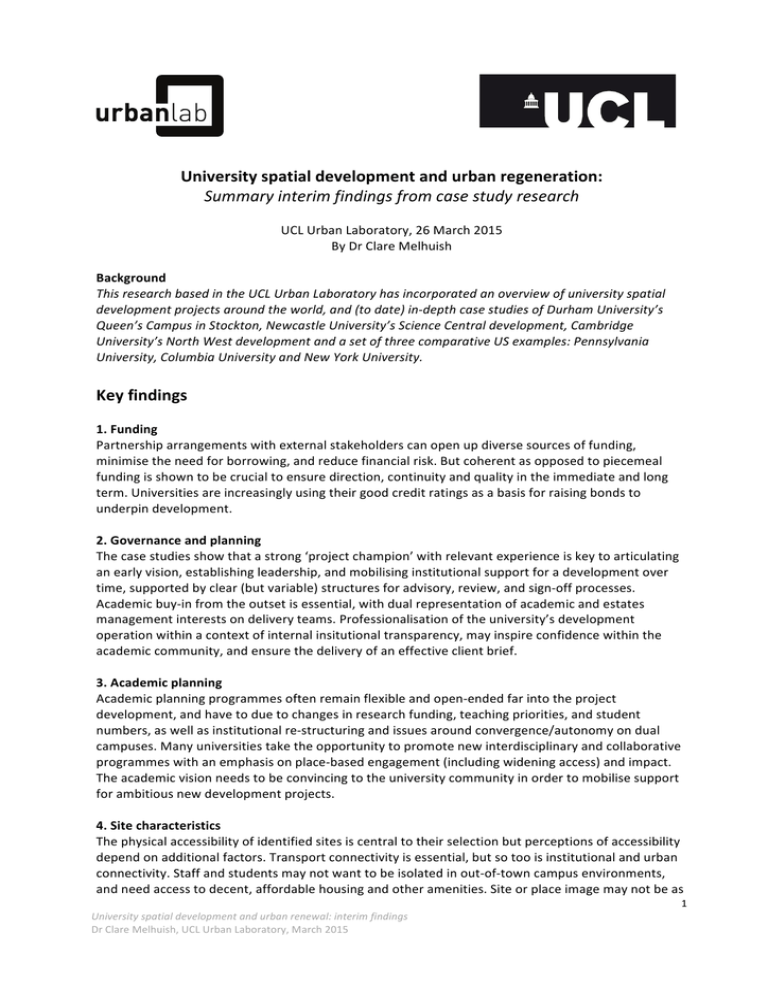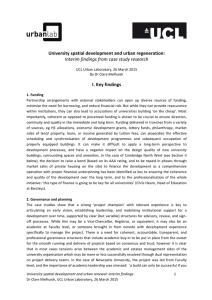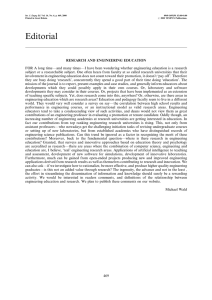Document 12435523
advertisement

University spatial development and urban regeneration: Summary interim findings from case study research UCL Urban Laboratory, 26 March 2015 By Dr Clare Melhuish Background This research based in the UCL Urban Laboratory has incorporated an overview of university spatial development projects around the world, and (to date) in-­‐depth case studies of Durham University’s Queen’s Campus in Stockton, Newcastle University’s Science Central development, Cambridge University’s North West development and a set of three comparative US examples: Pennsylvania University, Columbia University and New York University. Key findings 1. Funding Partnership arrangements with external stakeholders can open up diverse sources of funding, minimise the need for borrowing, and reduce financial risk. But coherent as opposed to piecemeal funding is shown to be crucial to ensure direction, continuity and quality in the immediate and long term. Universities are increasingly using their good credit ratings as a basis for raising bonds to underpin development. 2. Governance and planning The case studies show that a strong ‘project champion’ with relevant experience is key to articulating an early vision, establishing leadership, and mobilising institutional support for a development over time, supported by clear (but variable) structures for advisory, review, and sign-­‐off processes. Academic buy-­‐in from the outset is essential, with dual representation of academic and estates management interests on delivery teams. Professionalisation of the university’s development operation within a context of internal insitutional transparency, may inspire confidence within the academic community, and ensure the delivery of an effective client brief. 3. Academic planning Academic planning programmes often remain flexible and open-­‐ended far into the project development, and have to due to changes in research funding, teaching priorities, and student numbers, as well as institutional re-­‐structuring and issues around convergence/autonomy on dual campuses. Many universities take the opportunity to promote new interdisciplinary and collaborative programmes with an emphasis on place-­‐based engagement (including widening access) and impact. The academic vision needs to be convincing to the university community in order to mobilise support for ambitious new development projects. 4. Site characteristics The physical accessibility of identified sites is central to their selection but perceptions of accessibility depend on additional factors. Transport connectivity is essential, but so too is institutional and urban connectivity. Staff and students may not want to be isolated in out-­‐of-­‐town campus environments, and need access to decent, affordable housing and other amenities. Site or place image may not be as University spatial development and urban renewal: interim findings Dr Clare Melhuish, UCL Urban Laboratory, March 2015 1 important in an international market for staff and students as sometimes suggested, so long as the facilities are good by comparison with other institutions. 5. Planning and regeneration contexts Universities are aware of the need for long-­‐term preparatory work to build relationships with local city authorities and garner support for the realisation of their own ambitions within the context of larger planning and economic regeneration contexts in which they are seen to have a role to play. Universities often benefit from advantageous planning agreements even though they may be required to provide benefits in return (eg commercial access to research facilities and resources, housing and social infrastructure for the benefit of the wider community). However, promises of job creation are usually restricted to mainly highly-­‐qualified and/or migrant knowledge workers rather than local, lower-­‐skilled candidates. And while large incoming student populations can increase spending in local areas, they may also unbalance local economies and existing demographics and so require careful management. 6. Masterplanning and design Planning and design quality of new spatial development initiatives consistently shows up as key to their success, not only in terms of staff and student satisfaction, but also in terms of how the university is perceived by neighbouring communities and local authorities, especially from the perspective of sustainability. Universities are usually expected to lead the way in realising exemplary flagship developments, both in terms of design quality and environmental sustainability. Social sustainability also comes hand in hand with the latter, generating public access to university sites and enhanced social infrastructure provision for both the university and wider communities. 7. Briefing and appointments Although architects acknowledge that the HE sector is one of the better ones to work in, and describe academics as generally good clients to work with, architects, academics and estates managers do not always see eye-­‐to-­‐eye on the briefing and procurement process, and many tensions arise in the negotiation of relationships and aspirations at this stage of university development plans. Universities need to invest adequate time and resources in information-­‐gathering and consultation at an early stage. Otherwise, masterplanners and architects often end up assuming the role of mediator and using valuable time in the design process on resolving internal issues. 8. Community relations/ engagement Investment in community engagement and building relationships with neighbours and external stakeholders over the long term now underpins most universities’ strategies for development and expansion, and is usually promoted by urban policy guidelines around social inclusion and local participation in planning processes. However universities are often criticised for misunderstanding the real social dynamics of local areas which surround their sites, and the depth of the cultural disengagement that can exist in local communities. Therefore, effective communication both within institutions (management, faculty, estates, and public engagement), and between institutions and their internal and external constituents, is essential to build trust, deliver a message about the nature and spirit of the university, and enable universities to contribute to the amelioration of urban problems. 9. Translation into place: construction dynamics Large-­‐scale, long-­‐term construction processes on urban sites usually generate intense disruption, pollution, and uncertainty for local communities for years at a time, which may also translate into University spatial development and urban renewal: interim findings Dr Clare Melhuish, UCL Urban Laboratory, March 2015 2 significant health problems and resentment. The management, containment, and amelioration of these processes through careful phasing, organisation of access, timing, and best practice is recognised by universities as fundamental to their development strategies. In addition, many institutions are looking into ways of promoting interim uses on site during the long process of development, in order to establish presence and dialogue with those most affected. University spatial development and urban renewal: interim findings Dr Clare Melhuish, UCL Urban Laboratory, March 2015 3





